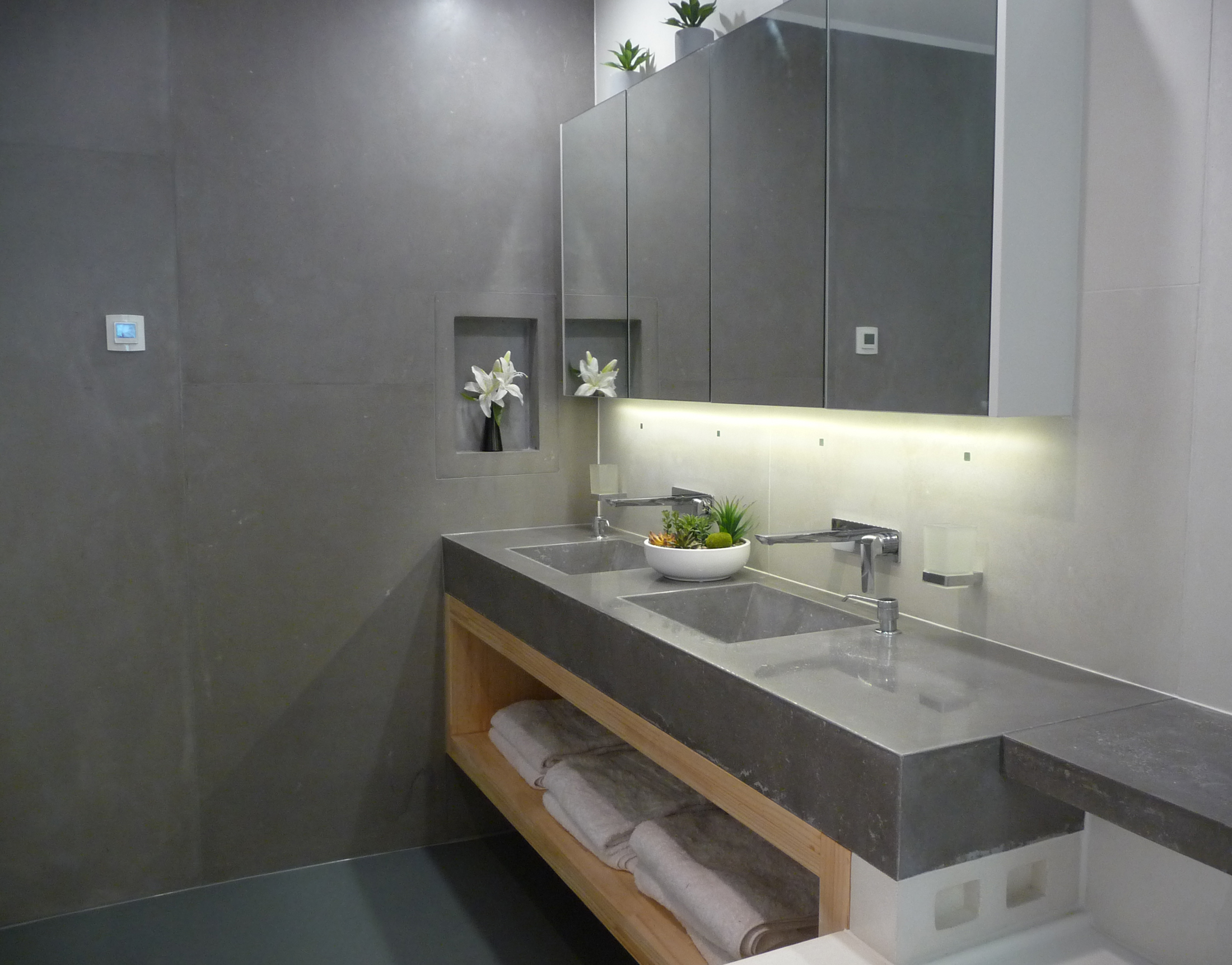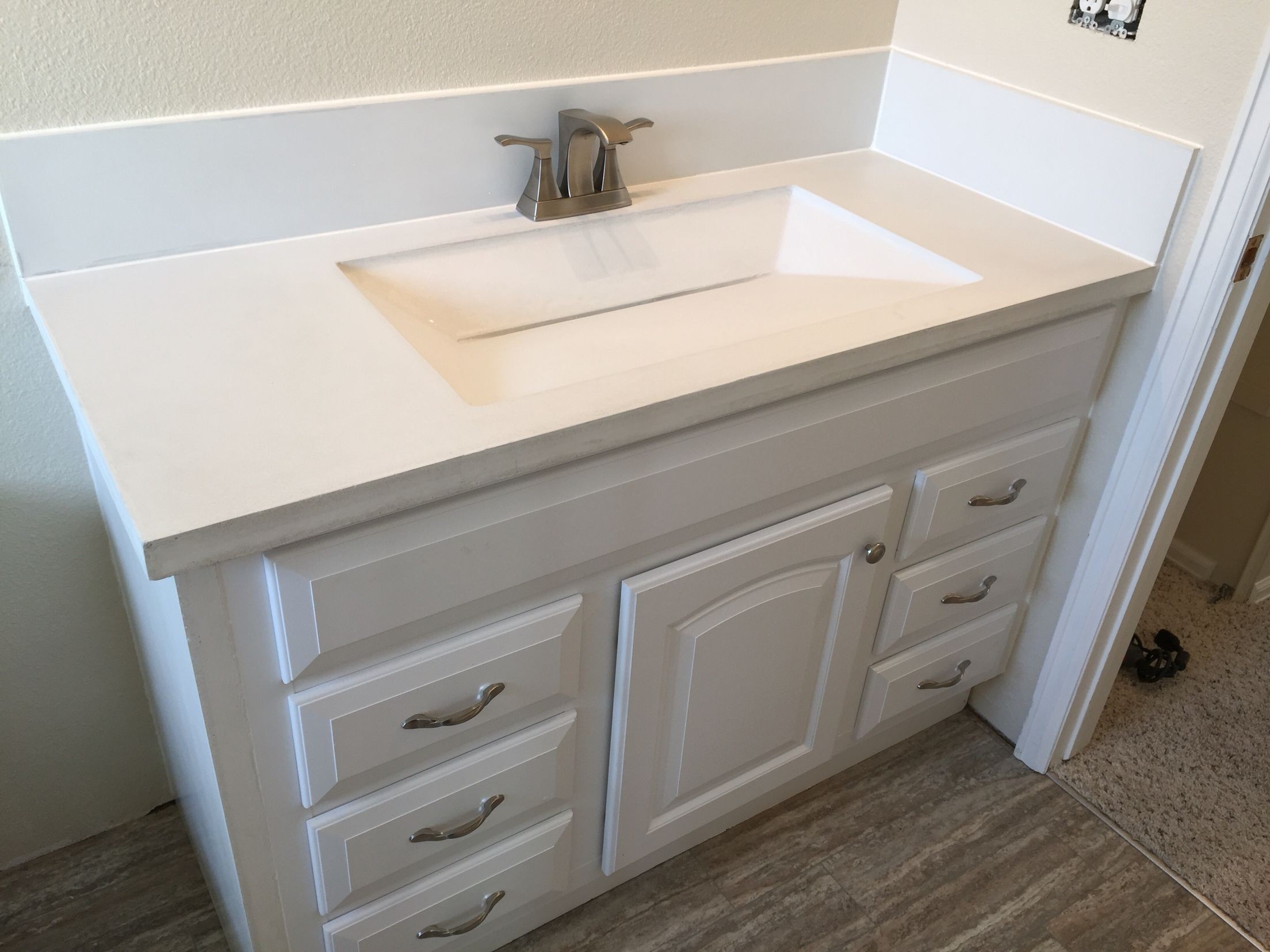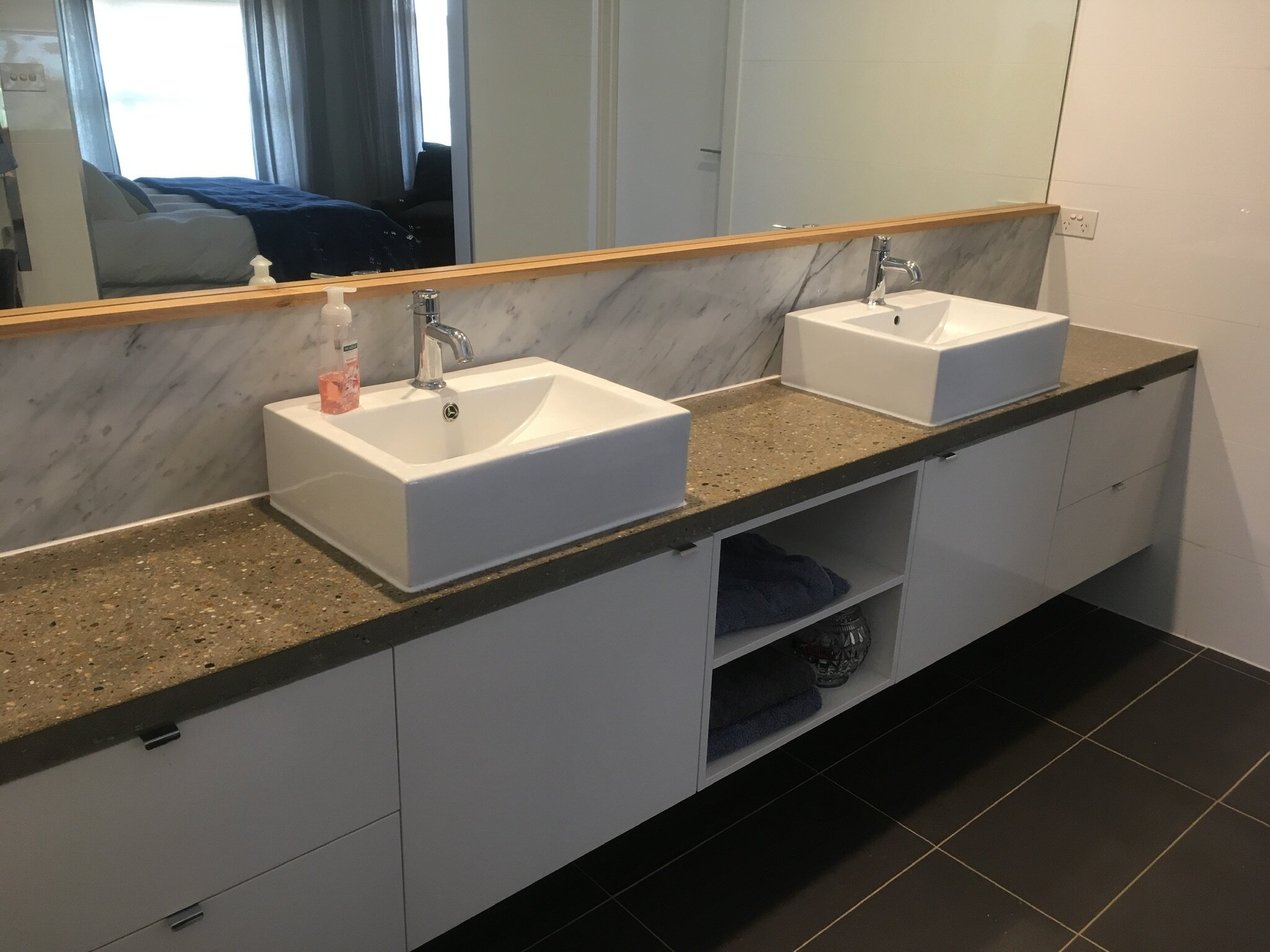The Appeal of Concrete Countertops for Bathroom Vanities: Concrete Countertop For Bathroom Vanity

Concrete countertops are increasingly gaining popularity for bathroom vanities due to their unique combination of aesthetics, durability, and customization options. They offer a modern and sophisticated look that complements various bathroom styles, from minimalist to industrial.
Aesthetic Appeal of Concrete Countertops
Concrete countertops offer a distinctive aesthetic that sets them apart from traditional countertop materials. Their natural texture and color variations create a unique and visually appealing surface. The inherent imperfections in concrete, such as subtle cracks and veining, contribute to its rustic charm and organic feel.
Concrete countertops are available in a wide range of colors and finishes, allowing for complete customization to match any bathroom décor.
Concrete countertops can be polished to achieve a smooth and glossy finish, or left unpolished for a more textured and industrial look. The color of the concrete can be customized by adding pigments during the mixing process. This allows homeowners to create countertops that perfectly complement the existing color scheme of their bathroom.
Durability and Longevity of Concrete Countertops
Concrete countertops are renowned for their exceptional durability and longevity. They are highly resistant to scratches, stains, and heat, making them ideal for high-traffic areas like bathrooms.
Concrete is a non-porous material, making it resistant to water damage and mold growth.
Unlike other countertop materials, such as granite or marble, concrete is not susceptible to etching from acidic substances, such as citrus juices or cleaning products. This makes them an excellent choice for bathrooms, where spills and splashes are common.
Concrete countertops are also highly resistant to heat, making them suitable for placing hot items, such as curling irons or hair dryers, directly on the surface. Their durability ensures that they will last for many years with minimal maintenance.
Design Considerations for Concrete Bathroom Vanities

Concrete countertops offer a unique blend of durability and design flexibility, making them an excellent choice for bathroom vanities. When designing a concrete vanity, careful consideration should be given to various design elements that will shape the final look and functionality of the space.
Sink Styles
The sink style is a crucial element in any bathroom vanity design. Concrete countertops accommodate a wide range of sink styles, each offering distinct advantages.
- Undermount Sinks: Seamlessly integrated into the countertop, undermount sinks create a clean, modern aesthetic and maximize counter space. They are particularly well-suited for smaller bathrooms.
- Vessel Sinks: These distinctive sinks sit atop the countertop, adding a touch of elegance and sophistication. Vessel sinks are available in various materials and designs, allowing for customization.
- Integrated Sinks: For a truly unique look, consider integrating the sink directly into the concrete countertop. This seamless design eliminates the need for separate sink basins and creates a monolithic, minimalist aesthetic.
Storage Solutions
Storage is essential in any bathroom, and concrete vanities offer versatile options to meet diverse storage needs.
- Drawers: Concrete vanity drawers provide ample storage space for toiletries, towels, and other bathroom essentials. They can be designed with soft-close mechanisms for a quiet and smooth operation.
- Cabinets: For larger bathrooms, cabinets offer a more expansive storage solution. They can be customized with shelves, drawers, and dividers to accommodate various items.
- Open Shelving: Open shelving adds visual interest and accessibility to the vanity. It is ideal for displaying decorative items or frequently used toiletries.
Hardware Choices
Hardware choices play a significant role in the overall design of a concrete vanity. From pulls and knobs to hinges and faucets, the right hardware can enhance the aesthetic and functionality of the vanity.
- Handles and Knobs: Choose handles and knobs that complement the style of the vanity and bathroom. Modern vanities often feature minimalist hardware, while traditional styles may incorporate more ornate designs.
- Hinges: High-quality hinges ensure smooth and reliable operation of vanity doors and drawers. Soft-close hinges add a touch of luxury and minimize noise.
- Faucets: Concrete vanities can accommodate a wide range of faucet styles, from contemporary to traditional. Consider the overall design of the bathroom when selecting a faucet.
Finishes and Sealants
Concrete countertops offer a variety of finishes and sealants that influence their appearance and functionality.
- Polished Finish: A polished finish creates a smooth, glossy surface that is easy to clean and resistant to stains. It adds a modern and elegant touch to the vanity.
- Honed Finish: A honed finish provides a matte, velvety surface that is less reflective than a polished finish. It offers a more understated and natural look.
- Acid Stain: Acid stains react with the concrete, creating unique and intricate patterns. This technique adds depth and character to the countertop.
- Sealants: Concrete countertops require sealing to protect them from stains, water damage, and wear. Sealants create a protective barrier that enhances the durability and longevity of the countertop.
Integrating Concrete Countertops into Bathroom Styles, Concrete countertop for bathroom vanity
Concrete countertops can seamlessly blend into various bathroom styles, adding a touch of industrial chic, rustic charm, or modern sophistication.
- Modern Bathroom: In a modern bathroom, a concrete countertop with a polished finish and minimalist hardware creates a sleek and contemporary look. Undermount sinks and integrated storage solutions enhance the streamlined aesthetic.
- Traditional Bathroom: Concrete countertops can also be integrated into traditional bathroom designs. A honed finish with a distressed or antique-inspired look adds warmth and character to the space. Vessel sinks and ornate hardware can complement the traditional style.
- Farmhouse Bathroom: Concrete countertops with a rustic finish and natural wood accents create a welcoming and cozy farmhouse aesthetic. Open shelving and a distressed wood vanity base add to the charm of the space.
Installation and Maintenance of Concrete Bathroom Vanities

Installing a concrete countertop for a bathroom vanity is a process that requires careful planning and execution. Whether you choose to hire a professional or tackle the project yourself, understanding the steps involved and the importance of proper sealing and maintenance is crucial for ensuring the longevity and beauty of your concrete countertop.
Installation of Concrete Bathroom Vanities
Installing a concrete countertop for a bathroom vanity involves several key steps, including preparation, fabrication, and finishing. The process can be broken down into the following stages:
- Preparation: Before beginning the installation process, it’s essential to prepare the area. This includes ensuring the vanity base is level and stable, as well as measuring and marking the countertop’s desired size and shape. It’s also important to protect surrounding surfaces from spills and dust.
- Fabrication: Concrete countertops are typically fabricated off-site. This process involves mixing concrete with pigments and aggregates to achieve the desired color and texture. The concrete is then poured into molds and allowed to cure for a specified period. Once cured, the countertop is carefully removed from the mold and polished to achieve a smooth, durable finish.
- Installation: The installation of the countertop involves carefully positioning it on the vanity base. It’s important to ensure that the countertop is properly supported and secured to prevent cracking or movement. This may involve using adhesives, brackets, or other fastening methods, depending on the specific countertop design and the vanity base.
- Finishing: The final step in the installation process is finishing. This may involve applying a sealant to protect the concrete from stains and water damage, and polishing the surface to achieve a desired sheen. The specific finishing techniques will depend on the desired look and the type of concrete used.
Maintenance of Concrete Bathroom Vanities
Concrete countertops are known for their durability, but they require proper sealing and maintenance to prevent staining and ensure their longevity.
- Sealing: Applying a sealant to the surface of the concrete countertop is crucial for protecting it from stains and water damage. The sealant acts as a barrier, preventing liquids from penetrating the porous concrete surface. It’s important to choose a sealant specifically designed for concrete countertops and to reapply the sealant periodically, typically every 1-2 years, depending on the amount of use and the type of sealant used.
- Cleaning: Regular cleaning is essential for maintaining the beauty and hygiene of your concrete countertop. Use a mild soap and warm water to clean the surface, avoiding harsh chemicals or abrasive cleaners that can damage the sealant or the concrete itself. It’s also important to dry the surface thoroughly after cleaning to prevent water spots or mildew growth.
- Protection: To prevent scratches and damage, use cutting boards and trivets when placing hot items on the countertop. Avoid placing sharp objects directly on the surface, and be careful when using cleaning tools or utensils. These simple precautions can help extend the life of your concrete countertop.
Hiring a Professional vs. DIY
Deciding whether to hire a professional or attempt a DIY installation for your concrete countertop is a personal choice based on your skills, time, and budget. Here is a table comparing the pros and cons of each approach:
| Professional Installation | DIY Installation | |
|---|---|---|
| Pros | Expert craftsmanship and knowledge, guaranteed results, less risk of mistakes, potential for warranty | Cost savings, greater control over the project, potential for satisfaction from completing a challenging task |
| Cons | Higher cost, less flexibility in design and customization, reliance on availability of professionals | Potential for mistakes, time commitment, need for specialized tools and equipment, potential for injury |
